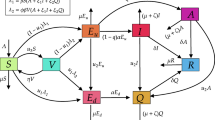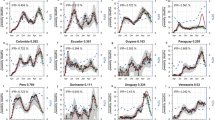Abstract
The nexus of factors influencing the dissemination of the SARS-CoV-2 virus is so complex that identification of (some) determining factors of COVID-19 spatial diffusion is significantly hampered. COVID-19 characterize of specific dynamics and enormous volume of morbidity. The aim of the study is construction of the model of spatial dissemination of COVID-19 in Poland, identification of the main outbreak places and spatial heterogeneity of pandemic based on the spatial set of first twelve months morbidity data (in 2020 and 2021). The target (prototypical) model is intended rather as the supporting tool than replacement of the well-known and used SIR or SEIR (Susceptible – Exposed – Infected - Recovered) models in epidemiology. It also assumed that the target model could be used as a priori estimation tool of the spatial locations of infections outbreaks as well as evaluation of future volume of infections due to changing numbers of exposed and recovered persons related also to, newly, introduced and continuation coronavirus (COVID-19) vaccinations. One of the expected advantages of the construed model is its spatial aspect i.e. it will enable to evaluate the potential spatial differentiation of infected number of people within the set of observed spatial units i.e. counties in Poland.
Access this chapter
Tax calculation will be finalised at checkout
Purchases are for personal use only
Similar content being viewed by others
Notes
- 1.
Susceptible – Exposed – Infected – Recovered.
- 2.
i.e. a state of isolation or restricted access instituted as a security measure.
References
Past plagues offer lessons for society after the coronavirus pandemic. https://www.sciencenews.org/article/coronavirus-covid-19-ancient-plagues-pandemics-lessons-society. Accessed on 20 Jan 2021
Smith, C.D., Mennis, J.: Incorporating geographic information science and technology in response to the COVID-19 pandemic. Prev. Chronic. Dis. 17 (2020). https://doi.org/10.5888/pcd17.200246.
Dangermond, J., Vito, C.D., Pesaresi, C.: Using GIS in the Time of the COVID-19 Crisis, casting a glance at the future. A joint discussion. J-READING - J. Res. Didactics Geography. 1, 195–205 (2020).
Petersen, E., et al.: Comparing SARS-CoV-2 with SARS-CoV and influenza pandemics. Lancet. Infect. Dis 20, e238–e244 (2020). https://doi.org/10.1016/S1473-3099(20)30484-9
Murgante, B., Borruso, G., Balletto, G., Castiglia, P., Dettori, M.: Why Italy first? health, geographical and planning as-pects of the COVID-19 Outbreak. Sustainability. 12, 5064 (2020). https://doi.org/10.3390/su12125064
Paez, A., Lopez, F.A., Menezes, T., Cavalcanti, R., da Rocha Pitta, M.G.: A spatio‐temporal analysis of the environmental correlates of COVID‐19 incidence in Spain. Geograph. Anal. 53(3), 397–421 (2020)
Confalonieri, U., et al.: Human health. Climate change 2007: impacts, adaptation and vulnerability: contribution of Working Group II to the fourth assessment report of the Intergovernmental Panel on Climate Change (2007)
Kimura, Y., et al.: Geodemographics profiling of influenza A and B virus infections in community neighborhoods in Japan. BMC Infect. Dis. 11, 1–12 (2011)
Merler, S., Ajelli, M.: The role of population heterogeneity and human mobility in the spread of pandemic influenza. Proc. Royal Soc. B: Biol. Sci. 277, 557–565 (2010)
Duszyński, J., et al.: Zrozumieć COVID-19. Opracowanie zespołu ds. COVID-19 przy Prezesie PAN (2020)
Hamidi, S., Sabouri, S., Ewing, R.: Does density aggravate the COVID-19 pandemic?: early findings and lessons for planners. J. Am. Plann. Assoc. 86, 495–509 (2020). https://doi.org/10.1080/01944363.2020.1777891
Śleszyński, P.: Prawidłowości przebiegu dyfuzji przestrzennej rejestrowanych zakażeń koronawirusem SARS-COV-2 w Polsce w pierwszych 100 dniach epidemii. Czasopismo Geograficzne91, 5–19 (2020)
Iwańczak, B.: Zróżnicowanie przestrzenne zagrożenia grypą w Polsce. Prace i Studia Geograficzne 57, 127–144 (2015)
Kirby, R.S., Delmelle, E., Eberth, J.M.: Advances in spatial epidemiology and geographic information systems. Ann. Epidemiol. 27, 1–9 (2017). https://doi.org/10.1016/j.annepidem.2016.12.001
Brauer, F.: Mathematical epidemiology: past, present, and future. Infectious Disease Modelling. 2, 113–127 (2017). https://doi.org/10.1016/j.idm.2017.02.001
Kiss, I.Z., Miller, J.C., Simon, P.L.: Mathematics of Epidemics on Networks, vol. 598. Springer, Cham (2017). https://doi.org/10.1007/978-3-319-50806-1
Pourbohloul, B., Miller, J.: Network Theory and the Spread of Communicable Diseases (2021)
CovsirPhy Development Team: CovsirPhy, Python package for COVID-19 analysis with SIR-derived ODE models. https://github.com/lisphilar/covid19-sir. Accessed on 04 Feb 2021
Guidotti, E., Ardia, D.: COVID-19 Data Hub. JOSS. 5, 2376 (2020). https://doi.org/10.21105/joss.02376.
ICM UW Model description – COVID. https://covid-19.icm.edu.pl/en/model-description/. Accessed on 12 Feb 2021
Stewart, J.Q.: Empirical mathematical rules concerning the distribution and equilibrium of population. Geogr. Rev. 37, 461–485 (1947)
Pomianowski, W.: Transportation network structure and spatial accessibility. Dynamic graph approach (2018)
Johnston, R.: The Dictionary of Human Geography. Wiley-Blackwell, Oxford (1985)
Yan, X.-Y., Zhou, T.: Destination choice game: a spatial interaction theory on human mobility. Sci. Rep. 9, 9466 (2019). https://doi.org/10.1038/s41598-019-46026-w
Wilson, A.G.: Entropy in Urban and Regional Modelling. Pion, London (1970)
O’Kelly, M.E.: Spatial interaction models. In: International Encyclopedia of Human Geography. pp. 365–368. Elsevier (2009). https://doi.org/10.1016/B978-008044910-4.00529-0.
Rees, P., Dennett, A.: Alan Wilson – contributions to research on population and migration. Interdisc. Sci. Rev. 44, 249–271 (2019). https://doi.org/10.1080/03080188.2019.1670428
Wilson, A.: Epidemic models with geography. https://arxiv.org/abs/2005.07673v1 (2020)
Werner, P.: Simulating of accessibility of ICT infrastructure in Poland using geographical potential models. In: Proceedings of the 16th International Conference on System Science. pp. 261–269. Wroclaw University of Technology (2007)
Werner, P.: Symulacja Monte Carlo rozwoju sieci teleinformatycznych, radiokomunikacji i radiodyfuzji w Polsce (na podstawie modeli potencjału geograficznego). Archiwum Fotogrametrii, Kartografii i Teledetekcji. vol. 13 (2003)
Werner, P.: Geograficzne uwarunkowania rozwoju infrastruktury spoleczenstwa informacyjnego w Polsce. Uniwersytet Warszawski, Wydz. Geografii i Studiów Regionalnych, Warszawa (2003)
Werner, P.: Konstrukcja i interpretacja modeli potencjału geograficznego w badaniach sieci teleinformatycznych. In: Problemy interpretacji wyników metod badawczych stosowanych w geografii społeczno-ekonomicznej i gospodarce przestrzennej: praca zbiorowa. Bogucki Wydaw. Naukowe (2003)
Tobler, W.R.: Cellular geography. In: Gale, S. and Olsson, G. (eds.) Philosophy in Geography. pp. 379–386. Springer Netherlands, Dordrecht (1979). https://doi.org/10.1007/978-94-009-9394-5_18.
Batty, M.: Fifty years of urban modeling: Macro-statics to micro-dynamics. In: The dynamics of complex urban systems. pp. 1–20. Springer (2008). https://doi.org/10.1007/978-3-7908-1937-3_1
Wilson, A.G.: Complex spatial systems: the modelling foundations of urban and regional analysis. Pearson Education (2000)
Oshan, T.M.: A primer for working with the Spatial Interaction modeling (SpInt) module in the python spatial analysis library (PySAL). REGION. 3, 11 (2016). https://doi.org/10.18335/region.v3i2.175.
Fotheringham, A.S., O’Kelly, M.E.: Spatial interaction models: formulations and applications. Kluwer Academic Publishers, Dordrecht, Boston (1989)
Raport zakażeń koronawirusem (SARS-CoV-2) - Koronawirus: informacje i zalecenia - Portal Gov.pl. https://www.gov.pl/web/koronawirus/wykaz-zarazen-koronawirusem-sars-cov-2. Accessed on 07 Feb 2021
Akaike, H.: A new look at the statistical model identification. IEEE Trans. Automat. Contr. 19, 716–723 (1974). https://doi.org/10.1109/TAC.1974.1100705
20 tys. zakażeń dziennie? Eksperci mówią, że tę liczbę należy pomnożyć przez 10. https://biqdata.wyborcza.pl/biqdata/7,159116,26507630,20-tys-zakazen-dziennie-eksperci-mowia-ze-te-liczbe-nalezy.html. Accessed on 12 Feb 2021
Acknowledgment
This research was partially funded by IDUB against COVID-19 project granted by Warsaw University of Technology under the program Excellence Initiative: Research University (IDUB).
Author information
Authors and Affiliations
Corresponding author
Editor information
Editors and Affiliations
Rights and permissions
Copyright information
© 2021 Springer Nature Switzerland AG
About this paper
Cite this paper
Werner, P.A. (2021). Tracing and Modeling of the COVID-19 Pandemic Infections in Poland Using Spatial Interactions Models. In: Gervasi, O., et al. Computational Science and Its Applications – ICCSA 2021. ICCSA 2021. Lecture Notes in Computer Science(), vol 12954. Springer, Cham. https://doi.org/10.1007/978-3-030-86979-3_45
Download citation
DOI: https://doi.org/10.1007/978-3-030-86979-3_45
Published:
Publisher Name: Springer, Cham
Print ISBN: 978-3-030-86978-6
Online ISBN: 978-3-030-86979-3
eBook Packages: Computer ScienceComputer Science (R0)




